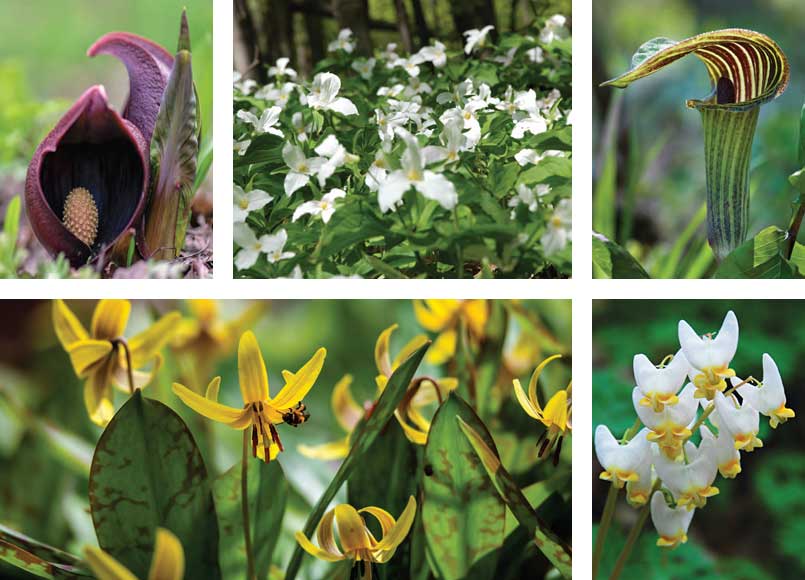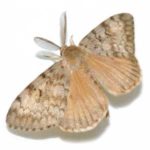
from left to right; skunk cabbage, white trillium, jack-in-the-pulpit, yellow trout lily, Dutchman’s breeches
Something beautiful happened around 120 million years ago. Think of it as the first spring when, in one of those magical evolutionary moments, flowers and pollinators began the dance of co-existence, a dance that continues to brighten our world to this day. When viewed through the lens of evolution, the annual dance of the spring ephemerals is short and very sweet.
The spring ephemerals arrive with the warmth of the April sun, carpeting the forest floor with natural beauty when the tree canopy is open and leafless. But their beauty is fleeting. Their blossoms disappear as the forest fills in and filters out the sunshine.
In Watershed country, the most recognizable spring ephemeral is the trillium. We all recognize the white trillium, but sharp-eyed woodland walkers will spot the red trillium, the painted and nodding trillium as well.
The red trillium goes to remarkable lengths to ensure its pollination, combining both colour and odour to trick carrion flies into delivering pollen from one flower to the other. Its dark crimson colour deceives visitors into thinking they’ve come across a morsel of meat, an illusion backed up with an odour resembling a wet dog.
The trillium’s relationship with the insect world extends past pollination. As its flowers fade, the fruit develops and ripens later in the summer. It then splits open, exposing its seeds, each of which carries a nutritious food packet. Ants gather the seeds and take them back to their home, eat the food packets and deposit the seeds on their equivalent of a compost heap, planting new trilliums in a fertile and damp location.
The dispersal of native flower seeds by ants is known as “myrmecochory,” a tongue-twisting name given to a process employed by about one-third of the plants you’ll see in spring, including the yellow trout lily, hepatica, bloodroot, and the spring beauty.
Pollination and a symbiotic relationship with ants are only part of the story for the yellow trout lily, so named because its mottled yellow leaves resemble the skin of one of our favourite cold-water fish. Only about one in ten of pollinated trout lilies produces seed, a shortcoming more than made up for by the plant’s ability to reproduce asexually. Each plant produces a bulb, and these bulbs produce fleshy stems that produce more bulbs and more plants, in colonies that can be decades and even centuries old.
The yellow trout lily is common throughout eastern North America. Not so common is the white trout lily – more closely associated with Carolinian forests than our cooler climes. The exception is Prince Edward County where moderated lake temperatures mean that spring hikers can look for the white trout lily in their favourite forests.
If you enjoy the name trout lily as a fanciful reference, then you’ll love Dutchman’s breeches, a spring wildflower that combines delicate lace-like leaves with white flowers shaped like the traditional trousers of the Netherlands. The name is a distraction. What the flowers are really about is accommodating the bumblebee, which is able to separate the inner and outer petals so they can harvest pollen. Dutchman’s breeches are also called “staggerweed” for their hallucinogenic effect on grazing cattle.
What’s in a name? It’s a question you won’t have to ask of the spring beauty. Another early season bloomer common to the Carolinian region, the spring beauty can form thick carpets of soft pink and white flowers in the same open woods and rich deciduous forests where you’ll find trilliums. A beautiful combination for a springtime walk.
The hepatica was described as the “first flower of the Canadian spring” by Catharine Parr Traill, the pioneering early chronicler of the flora and fauna of our part of Ontario. We’ll speculate she would have also known about the ancient “doctrine of signatures,” which suggests hepatica – found here and in Europe and Asia – could treat liver ailments, because its three-lobed leaf was thought to resemble the human liver. We suggest you consign the “doctrine of signatures” to the bin of pseudoscience and restrict your consumption of hepatica to looking for its delicate flowers – varying from white to a lovely lavender – in the moist rich soils of local forests.
The skunk cabbage presents an interesting story of insect relationship and evolutionary adaptation. This wetland dweller is one of a small group of plant species capable of generating its own heat, producing temperatures 15 to 35°C warmer than the surrounding air. This warmth helps the plant emerge and flower despite cold temperatures, and together with the odour that gives the skunk cabbage its name, it attracts early pollinating insects.
Skunk cabbages grow in colonies, where they can live for decades. They are easily recognizable by their distinctive purple spathes. As spring gives way to summer, their cabbage-like leaves begin to spread, rotting quickly to contribute to a moist habitat supporting garter snakes, salamanders, turtles and dragonflies.
The skunk cabbage is not the only oddity to watch for this spring. The jack-in-the-pulpit hides its flowers in a fleshy green spike, which is further hidden under a green and dark-ochre striped funnel- shaped bract. Jack-in-the-pulpit goes by the alternative names “wild turnip” and “bog onion” and is said to have been used by Indigenous peoples as both food and medicine. But don’t be tempted to try this at home. In its roots there’s calcium oxalate, a poison that can cause vomiting and nausea. Look for jack-in-the-pulpit in the rich soils of cedar swamps and moist deciduous woods.
The delicately white, star-like flowers of the bloodroots push their way up through the leaf litter in early April. The bloodroot derives its name from the red fluid that flows from its cut roots, which Indigenous peoples used as dye and as an herbal remedy. They mixed it with maple syrup to create a lozenge they would prescribe to induce vomiting, believing it would cleanse the body of harmful toxins.
If you decide to wander through Watershed country this spring to contemplate the wildflowers and their intricate roles within the ecosystem, we have some recommendations. A favourite in any season is Peter’s Woods south of Rice Lake, one of the few places in our region where you can observe a forest with old-growth characteristics. Underneath the towering pines, oaks and maples you’ll find trillium and jack-in-the pulpit. There are more trilliums, and possibly hepatica, to be found in the Goodrich- Loomis Conservation Area north of Brighton, or in the Northumberland Forest. If you’re searching for rarity, look for the white trout lily in the Massassauga Point Conservation Area in Prince Edward County.
Story by:
Norm Wagenaar




